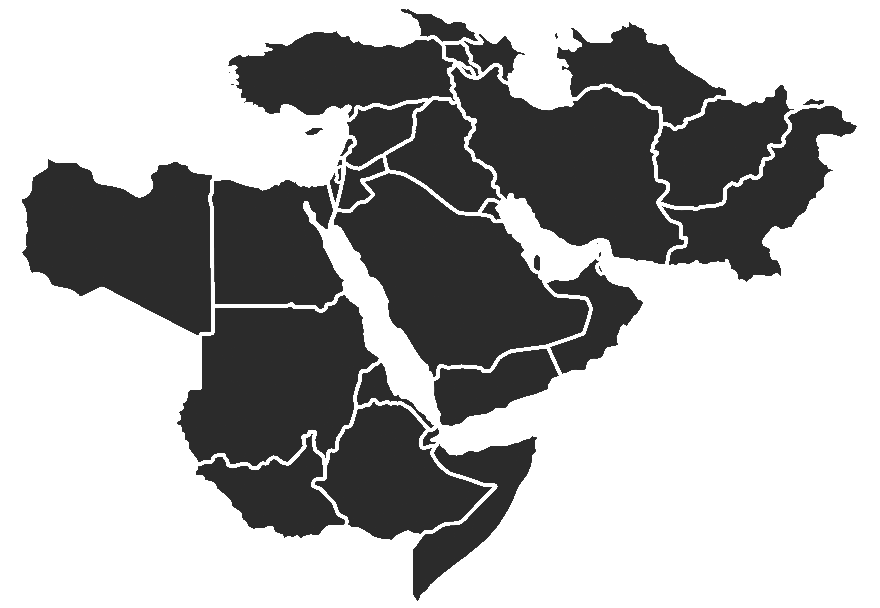{{currentView.title}}
October 06, 2023
Salafi-Jihadi Movement Weekly Update, October 4, 2023: Pakistan Suicide Bombings, Somalia Backsliding, Tribal Insurgency Challenges SDF, and Sahelian Juntas Face Internal Pressure
Data Cutoff: October 4, 2023, at 10 a.m.
Key Takeaways:
Iraq and Syria. Tribal insurgent attacks against the US-backed Syrian Democratic Forces (SDF) quintupled in the past week compared to previous weeks, a trend that will almost certainly cause the SDF to lose control over some of the population in southern Deir ez Zor province. The tribal insurgency’s increasing violence means the SDF will likely become less capable of supporting the primary US objective of countering ISIS.
Sahel. Worsening insurgencies are contributing to factionalism within the Burkinabe and Malian juntas, which could lead to additional coups. Factionalism in the military juntas will make them preoccupied with securing power, which will likely enable Salafi-jihadi insurgents to increase military pressure on politically sensitive areas, further eroding the juntas’ legitimacy.
Somalia. An al Shabaab offensive is setting conditions for the group to undo Somali Federal Government (SFG) gains made during its successful 2022 offensive. Al Shabaab will continue threatening to overturn SFG gains from the 2022 offensive as long as it retains havens in central Somalia.
Afghanistan-Pakistan. The Islamic State Khorasan Province (ISKP) and Islamic State Pakistan Province (ISPP) likely carried out separate suicide bombings in Pakistan on September 29. Pakistan is responding to increasing terrorism by planning to deport one million Afghan refugees, which will heighten tensions between the Taliban government and Pakistan and could increase support for the Tehrik-e-Taliban Pakistan (TTP). The Taliban does not have the logistical capacity to care for these refugees and will likely use the crisis to argue for international support.
Assessments:
Iraq and Syria.
Author: Brian Carter
Tribal insurgent attacks against the US-backed SDF quintupled in the past week compared to previous weeks, a trend that will almost certainly cause the SDF to lose control over some of the population in southern Deir ez Zor province. Anti-SDF attacks increased from 12 during the week of September 19–25 to 55 during the week of September 26–October 2.[1] This high rate of attacks risks forcing the SDF out of towns in southern Deir ez Zor, where the tribal insurgents are strongest and conduct most of their attacks.
The SDF is already frequently abandoning towns at night as a way to protect its forces from ISIS attacks, and in early September the SDF withdrew forces to avoid tribal attacks.[2] The rate of attacks against the SDF in central Deir ez Zor also threatens the SDF’s ability to support pro-SDF tribes such as the Shaytat.[3] The Shaytat tribe controls the Hajin Military Council, which is an Arab SDF military force.[4] The Hajin Military Council temporarily dissolved in early September after the SDF failed to support it against the tribal insurgents.[5]
- Tribal insurgents attacked SDF positions over 50 times between September 26 and October 2.[6] The insurgents only attacked SDF positions 16 times in the preceding week.[7] The insurgents concentrated the attacks between Jadeed Akidat in the north and Gharanij in the south (Figure 1).[8] ISIS is also very active in this area.
Figure 1. Tribal Attacks in Deir ez Zor Province
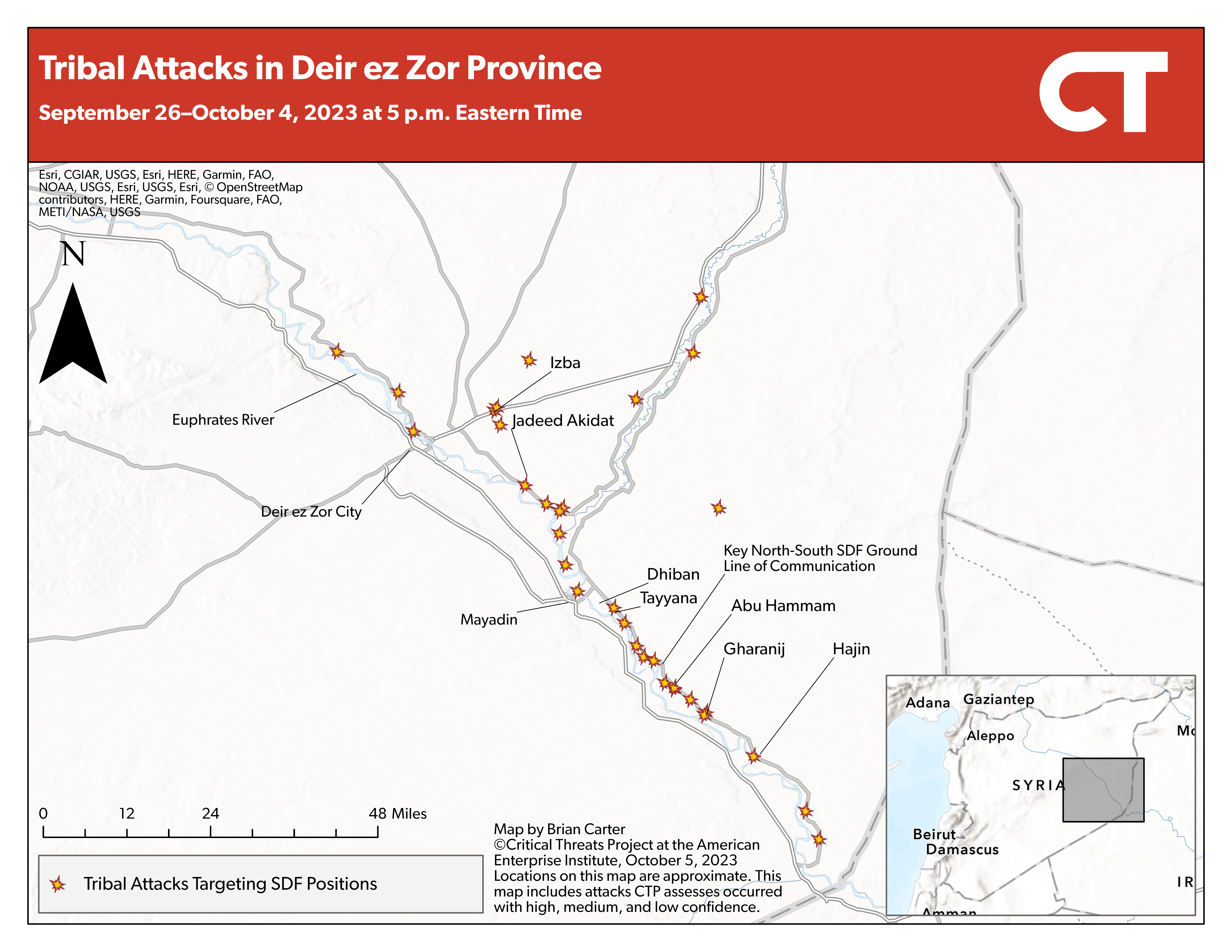
Source: Brian Carter.
- The SDF has previously chosen to withdraw its forces in specific areas to avoid enemy attacks against its positions, particularly at night. These withdrawals are an SDF decision to forfeit its control of the population. The SDF withdrew all of its Kurdish cadres—who hold most of the decision-making power in Deir ez Zor—from the province in early September.[9] The SDF also withdrew its forces from Dhiban and Tayyana on September 24–26, when tribal insurgents recaptured the towns. This withdrawal suggests that the SDF prioritized protecting its forces over repulsing the insurgent attack.
- The rate of attacks against the SDF in central Deir ez Zor threatens the SDF’s ability to support pro-SDF tribes, such as the Shaytat tribe.[10] Important SDF ground lines communication run through central Deir ez Zor, and there are no other easily accessible lines to Shaytat territory in southern Deir ez Zor. The Shaytat are strongly anti-ISIS and support the SDF because ISIS massacred up to 1,500 Shaytat in 2014.[11] An ISIS commander said in 2020 that his forces deliberately targeted Shaytat due to their collaboration with the US-led coalition and SDF.[12] The Shaytat tribe occupies territory along the Euphrates in Mayadin and Albu Kamal districts near Abu Hammam and Hajin, but SDF forces must drive through tribal insurgent attack zones to get to Shaytat areas.[13]
Figure 2. Tribal Attacks Against the SDF
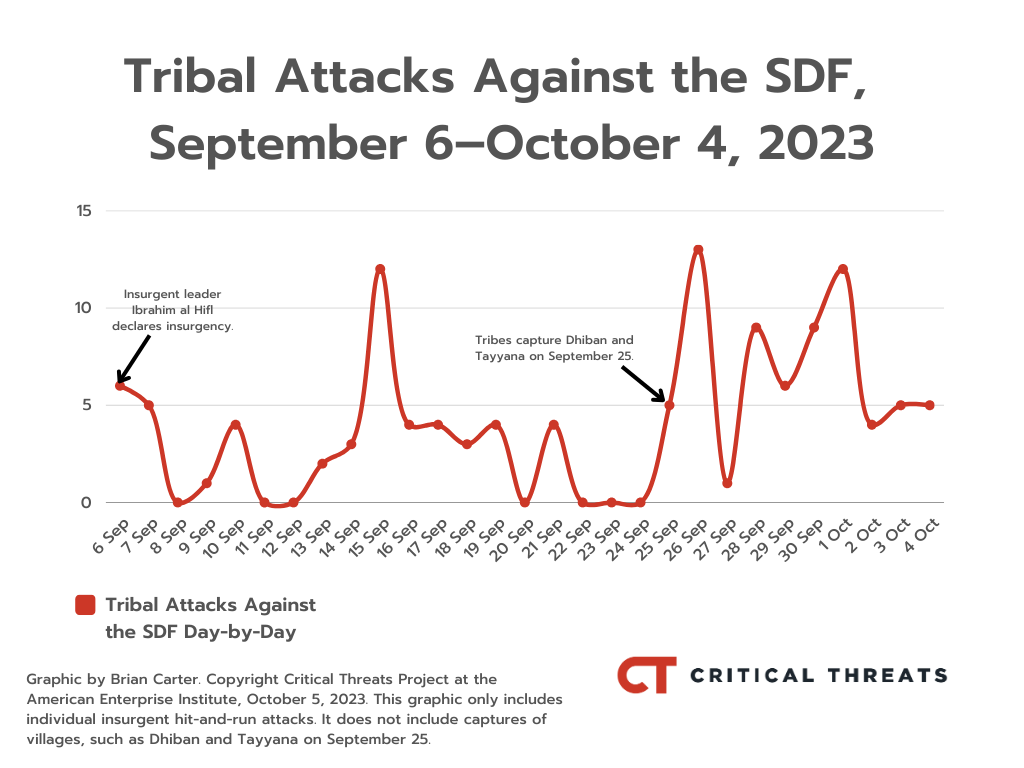
Source: Brian Carter.
The tribal insurgency’s increasing violence means the SDF will likely become less capable of supporting the primary US objective of countering ISIS. The SDF is using its premier counterterrorism units to fight the insurgents, meaning these units will have less capacity to conduct counter-ISIS operations.[14] The US counter-ISIS mission relies on partnered forces to combat ISIS, but the SDF is currently preoccupied with countering the tribal insurgency.[15] The more the anti-SDF insurgency expands, the fewer assets the SDF will be able to use against ISIS.
- The SDF is giving priority to the tribal insurgency, which prevents it from using all of its counterterrorism resources against ISIS. The SDF deployed armored vehicles, fighters, and artillery to Deir ez Zor from Hasakah, Manbij, and Raqqa on September 27.[16] The SDF also used its premier counterterrorism force against tribal fighters in Deir ez Zor.[17] This force normally targets ISIS, and using it against the tribal insurgency diminishes its capacity for counter-ISIS operations.
- The US mission in Syria relies on the SDF to carry out counter-ISIS operations.[18] Decreased SDF capacity due to the SDF’s prioritization of the tribal insurgency over ISIS means the US mission’s ability to successfully defeat ISIS will decrease.
ISIS is carrying out few attacks against the SDF, but it will very likely attempt to take advantage of the fighting to rest, refit, and strengthen its relationships with local tribesmen. ISIS has only claimed three attacks in SDF-controlled Syria since the insurgency’s beginning. ISIS does not claim all its attacks, and CTP continues to assess that ISIS is intentionally under-claiming attacks in Deir ez Zor.[19] The group also uses coercive measures to elicit support from the population in southern Deir ez Zor and leverages temporary SDF withdrawals to enable this effort.[20] ISIS cells are drawn from the local population, meaning they retain relationships in tribal communities and can re-penetrate these communities using those relationships. CTP maintains that ISIS is preparing for a resurgence after the US withdrawal, and the group retains the knowledge and experience to execute a resurgence.[21]
- ISIS remains active in Deir ez Zor, and it uses temporary SDF withdrawals to coerce support from the population. A regime-affiliated source reported that regime-backed National Defense Forces claimed that ISIS fighters cooperated with tribal fighters during fighting between the SDF and tribal insurgents near Dhiban in early September.[22] Temporary SDF nighttime withdrawals from Deir ez Zor’s towns before the tribal insurgency enabled ISIS to coerce support from the local population.[23] The SDF’s intermittent withdrawals from towns during the insurgency also provide opportunities for ISIS to reengage local tribesmen.[24]
- ISIS retains its own relationships within tribes and can re-penetrate tribal communities. ISIS recruits from individual tribes in Deir ez Zor, meaning those recruits are able to use their pre-ISIS networks to engage locals and re-penetrate tribal communities.[25]
- ISIS used a similar strategy aimed at reengaging and then co-opting tribal communities in Iraq in the late 2000s and early 2010s. ISIS’s predecessor, al Qaeda in Iraq (AQI), leveraged local Sunni grievances to reassert itself in Sunni areas.[26] AQI created a tribal engagement office in 2009 that it used to re-infiltrate tribes in Iraq. AQI used the Tribal Engagement Office to rebuild relationships with tribal networks disenchanted with the Iraqi government, which viewed the Sunni tribes with “great suspicion.”[27] The SDF’s suspicion of the Arab tribes today is evidenced by the SDF’s accusations that the Assad regime has co-opted the tribes—and by the SDF’s unwillingness to acknowledge tribal grievances. ISIS can leverage these dynamics in Deir ez Zor to co-opt tribes based on its institutional knowledge of its experience in Iraq.
Figure 3. The Salafi-Jihadi Movement in the Middle East
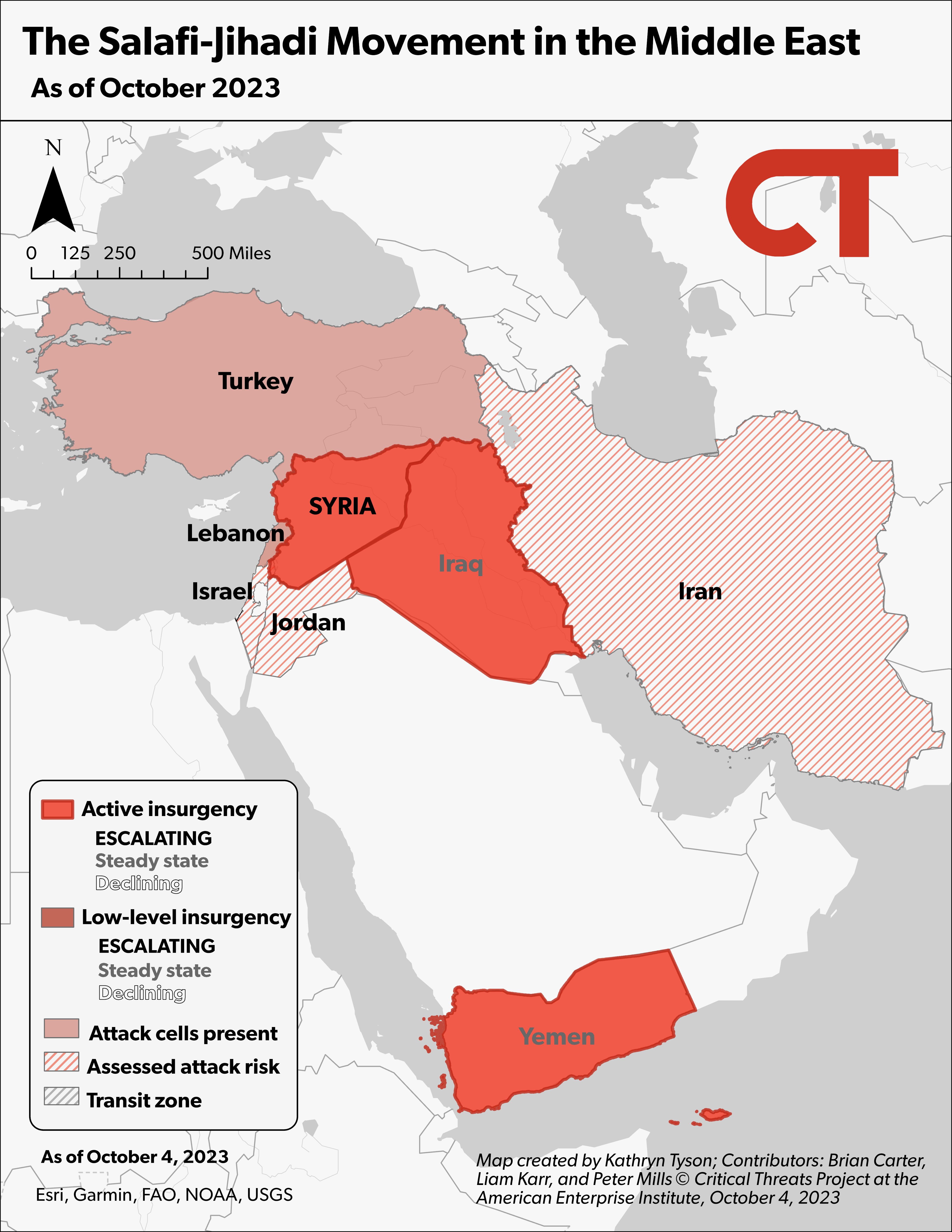
Source: Kathryn Tyson.
Sahel.
Author: Liam Karr
Worsening insurgencies are contributing to factionalism within the Burkinabe and Malian juntas, which could lead to additional coups. Both juntas took power promising to address insecurity, so the further erosion of security will likely damage their legitimacy and cohesiveness. The insurgencies in Burkina Faso and Mali have continued to worsen in recent months.
Al Qaeda–affiliated Jama’at Nusrat al Islam wa al Muslimeen (JNIM) and non-jihadist rebels with ties to JNIM have separately overrun Malian army bases seven times in September.[28] JNIM also killed more than 50 Burkinabe soldiers and civilian auxiliaries in northern Burkina Faso in the deadliest attack since the current junta took power in October 2022.[29] The worsening insurgencies have undermined the juntas’ control of some parts of their respective countries, which has further undermined their legitimacy and contributed to internal factionalism. Internal divisions directly contributed to the October 2022 Burkinabe coup and the 2023 Nigerien coup, and large-scale militant attacks preceded both Burkinabe coups in 2022.
- Investigative journalists and open-source intelligence accounts on Twitter have claimed that the Malian transitional head and defense minister have been at odds over military appointments and preferred security partners since at least July 2023.[30] Unverified claims on social media in September 2023 alleged that the schism over military appointments and partners spread to other military leaders.[31] The Burkinabe junta said it thwarted a coup attempt on September 26 and that it arrested several officers in connection with the alleged plot.[32] A September 20 report by Jeune Afrique cited several anonymous Burkinabe officials who claimed that multiple garrisons across multiple camps have lost confidence in the junta, suggesting that the junta faces a widespread legitimacy deficit.[33]
- Special forces units in Burkina Faso overthrew the previous junta during the October 2022 coup, partly because the special forces units did not receive expected patronage benefits and partly because the junta detained a special forces officer whom the democratic government had arrested.[34] The Nigerien Presidential Guards launched the July 2023 coup after the Nigerien president threatened to sack the unit’s commander. The Nigerien Presidential Guards commander now leads the Nigerien junta.[35]
- Salafi-jihadi militants killed over 50 Burkinabe soldiers in an attack in November 2021, which contributed to the Burkinabe military coup against the democratically elected Burkinabe government in January 2022.[36] The January 2022 junta failed to prevent large-scale Salafi-jihadi massacres, causing a second group of military leaders to oust the original junta in October 2022.[37]
Factionalism within the military juntas will preoccupy them with securing power, which will likely enable Salafi-jihadi insurgents to increase military pressure on politically sensitive areas. Ruling militaries threatened by internal factionalism and the loss of legitimacy may prioritize securing power over addressing insecurity.[38] Sahelian states’ Russian partners will not effectively support local security forces, because Russia is giving priority to replacing Wagner in Africa and maintaining its relationships with the juntas.[39]
The juntas drove their Western partners out of their countries between 2021 and 2023.[40] The lack of focus on counterinsurgency operations will create opportunities for Salafi-jihadi militants to consolidate control over contested areas and increase military pressure on politically sensitive parts of Burkina Faso and Mali with large-scale attacks and sieges, including suicide attacks. Increased insecurity in politically sensitive areas will further undermine the legitimacy of military rulers, leading to more internal dissent and creating additional opportunities for insurgents.
- The Kremlin-funded Wagner Group’s 1,000-strong contingent in Mali is smaller and less well equipped than the 2,400 French soldiers and 13,000 UN peacekeepers Wagner replaced.[41] Wagner’s arrival in Mali also greatly increased security force violence against civilians, which Salafi-jihadi insurgents use as a recruiting tool.[42] The Russian Ministry of Defense (MOD) has tried replacing Wagner’s Africa deployments with MOD-controlled mercenaries since the death of Wagner head Yevgeny Prigozhin on August 23.[43] Several Russian milbloggers have said since August that the MOD’s efforts have caused increased friction with Wagner fighters in the Sahel and weakened Wagner’s supply lines.[44]
- The Sahelian juntas have forced out most Western-backed support. The Burkinabe, Malian, and Nigerien juntas all annulled military agreements with France and effectively forced French forces to withdraw in February 2023, August 2022, and by the end of 2023, respectively.[45] The Malian junta also undermined Western-backed UN forces’ ability to carry out operations and advocated for an end to the mission, leading the UN to withdraw all forces by the end of 2023.[46]
- JNIM is already besieging regional capitals, cutting key transit routes, and attacking isolated bases in northern Mali and northern Burkina Faso.[47] The group also exponentially increased the rate of attacks in Mali’s capital region throughout 2023 and has continued to encircle and encroach on the Burkinabe capital over the same period.[48] Better-protected JNIM support zones allow the group to continue increasing the rate and severity of its attacks in more politically sensitive areas. JNIM conducted an attack using multiple suicide-vehicle borne improvised explosive devices (SVBIED) in the besieged regional capital Gao in northern Mali in September, and most recently conducted SVBIED attacks in Mali’s capital region in July 2022.[49]
Somalia.
Author: Liam Karr
Al Shabaab has waged an offensive in central Somalia since August 2023 that could set conditions for it to undo SFG gains made during the historic 2022 Somali offensive. Somali forces liberated large amounts of territory in central Somalia in 2022 during the first SFG-led offensive against al Shabaab.[50] Al Shabaab halted the SFG offensive with an SVBIED wave in January 2023 and repelled two SFG efforts to restart the offensive in April and August with more SVBIED attacks.[51]
Al Shabaab established a lodgment on the Shabelle River’s east bank in early September, which enables the group to infiltrate areas it lost in 2022 and reverse the SFG’s gains there.[52] The group simultaneously used another SVBIED wave beginning in late August 2023 to stymie Somali forces seeking to liberate the last al Shabaab–controlled district capitals in central Somalia.[53] The large number of SVBIEDs al Shabaab used in this effort and upcoming seasonal flooding suggests that al Shabaab’s current offensive will culminate in the coming weeks.[54]
- Approximately 120 al Shabaab fighters crossed the Shabelle River in early September and established dug-in defensive positions.[55] Somali forces and local militia began operations to clear the al Shabaab foothold on September 16 but have so far been unsuccessful.[56] African Union forces began mortaring al Shabaab’s positions on October 1 but have still not cleared the area.[57]
- Al Shabaab overran advancing Somali forces in central Somalia in a complex attack involving SVBIEDs on August 26.[58] The attack inflicted dozens of casualties and led Somali forces to withdraw from several key towns, including a district capital it had held since January.[59] The group has launched seven other SVBIED attacks in central Somalia since August 26.[60] Somali officials shifted tactics after the August 26 attack by having local militias lead the final push to clear al Shabaab from central Somalia. Somali officials are also rallying local support in the region.[61] However, the al Shabaab SVBIED wave risks undermining local support for the government by demonstrating the government is incapable of defeating al Shabaab or protecting civilians.
Figure 4. Somali Forces and al Shabaab Contest Central Somalia
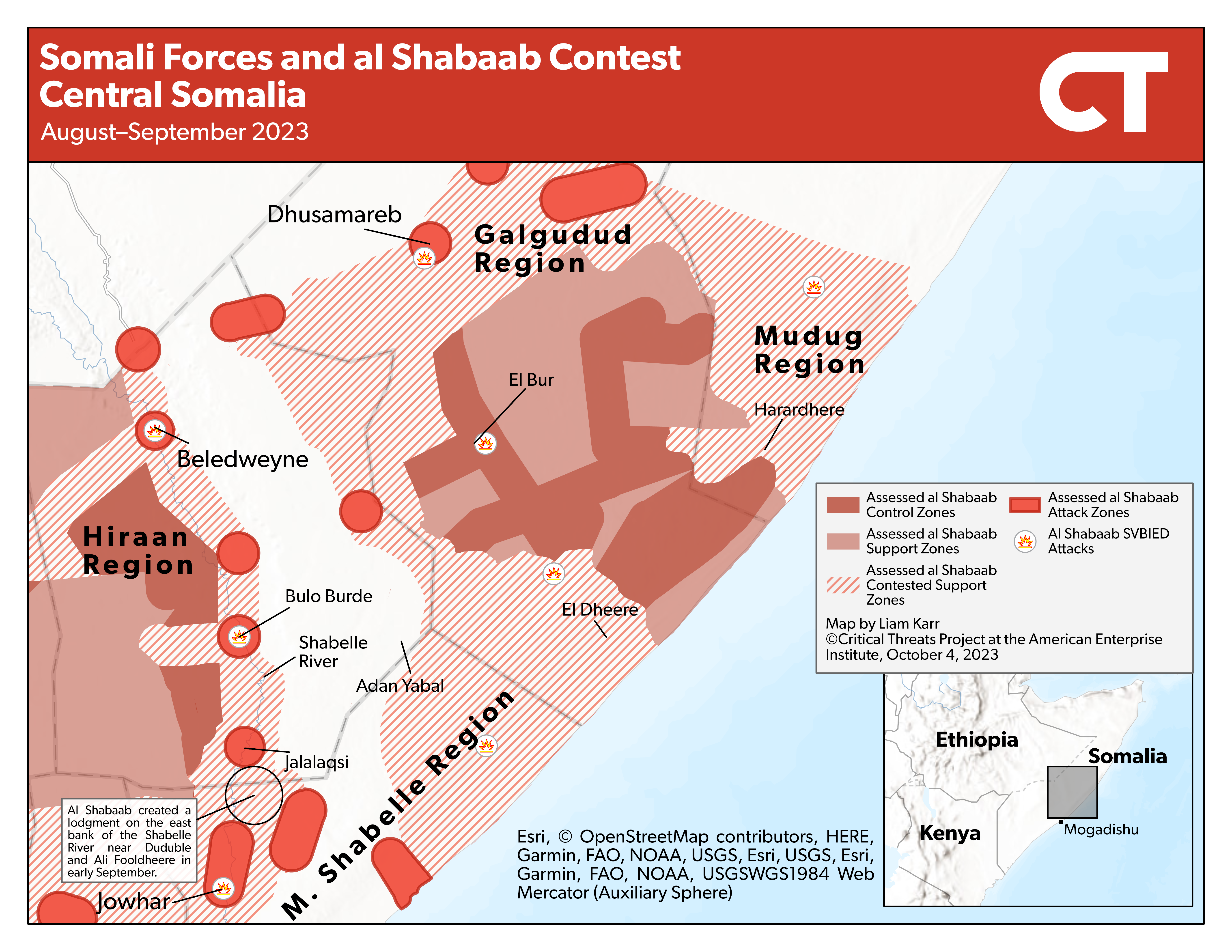
Source: Liam Karr.
Somali forces may not be ready to retake the initiative across all fronts when al Shabaab’s offensive culminates. Somali forces took nearly three months to resume the offensive after the January SVBIED wave and four months to resume the offensive after more SVBIED setbacks in April.[62] Somali forces have not resumed operations along the axis on which al Shabaab overran them in August, although Somali forces are still active in some parts of central Somalia.[63] Somali officials are also still meeting with community leaders to mobilize local forces for a renewed offensive.[64]
- Al Shabaab overran a Somali special forces base in central Somalia in a complex attack involving SVBIEDs on January 20.[65] The attack, in combination with the SFG’s lack of local support for local militias along other axes, halted the SFG offensive.[66] The SFG resumed the offensive along the same axis in early April, but another series of al Shabaab attacks involving SVBIEDs overran Somali forces again, stopping the resumed offensive.[67] This second setback halted the SFG offensive until August, when Somali forces attempted to restart the offensive along multiple axes.[68] The August 26 al Shabaab attack occurred along the same axis as the first two setbacks and paused the latest offensive.[69]
- The Somali president and other federal officials have visited frontline areas of central Somalia several times since early September, meeting with local leaders and military forces to negotiate and rally support for continuing the offensive against al Shabaab.[70] Clan elders from three major subclans in central Somalia agreed to a deal to join forces for an offensive against al Shabaab on October 2.[71]
Al Shabaab will continue threatening to overturn SFG gains from the 2022 offensive as long as it retains havens in central Somalia. Al Shabaab will be able to continue threatening to reestablish a foothold on the east bank of the Shabelle River because al Shabaab still controls the west bank of the river in central Somalia.[72] Al Shabaab has similarly been able to continue carrying out SVBIED waves from its havens in the Galgudud region because the group’s supply chains and local bomb-making facilities have remained intact.[73] Somali forces will have to clear these remaining havens to safeguard their successes from 2022.
Figure 5. The Salafi-Jihadi Movement in Africa
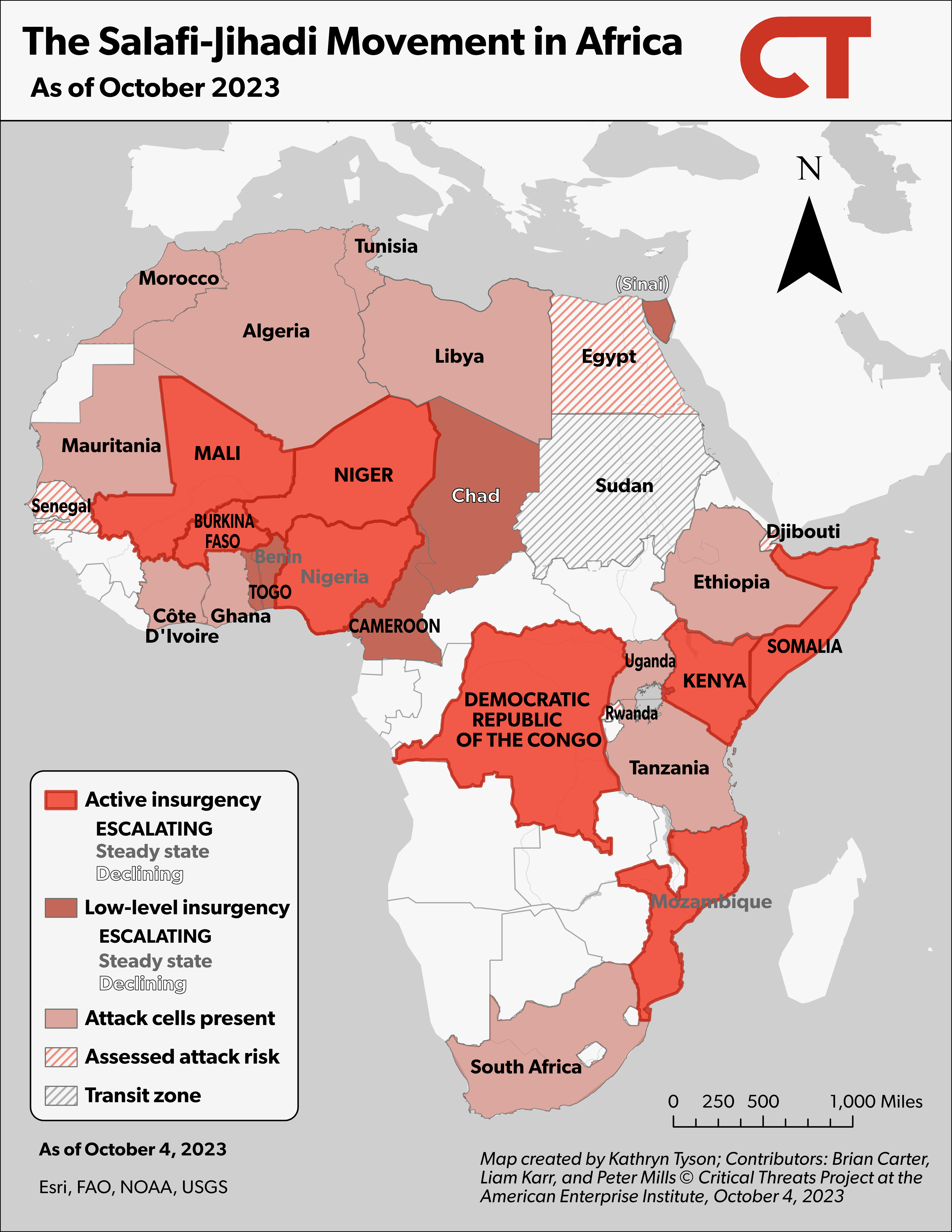
Source: Kathryn Tyson.
Afghanistan-Pakistan.
Author: Kathryn Tyson and Peter Mills
The ISKP and ISPP may have each conducted separate suicide bombings in Pakistan on September 29. The first bombing targeted a procession led by a Sufi-influenced religious sect in southwestern Pakistan, near ISPP attack zones.[74] The second bombing targeted a police mosque in northwestern Pakistan, near ISKP attack zones.[75] ISKP and ISPP also regularly target religious minorities and security forces in Pakistan. Attacks on civilians are prohibited under the TTP’s 2018 code of conduct, and such attacks have damaged TTP cohesion in the past, suggesting that TTP would limit targeting of civilians.[76]
- The TTP immediately denied responsibility for the attacks in Mastung in southwestern Balochistan Province and Hangu in northwestern Khyber Pakhtunkhwa Province.[77] The TTP frequently targets Pakistani security forces and politicians but has rarely attacked mosques or civilians since enacting its 2018 code of conduct, which prohibits attacks on civilians and places of worship. The TTP code aims to prevent internal divisions.[78] A TTP faction most recently attacked a mosque in January 2023, but TTP leadership denied responsibility.[79]
- ISKP and ISPP regularly attack religious minorities, including Sufis, and Pakistani police in Khyber Pakhtunkhwa and Balochistan.[80] ISKP and ISPP target religious minorities to establish religious legitimacy and stoke sectarian conflict.[81] ISKP and ISPP also target Pakistani police to degrade Pakistani state security.[82] This supports ISKP and ISPP’s efforts to undermine Pakistani state presence, which is a requisite step toward the Islamic State’s objective of territorial control.
- ISKP and ISPP maintain attack zones in Mastung and near Hangu. ISPP has had attack zones in Mastung since at least 2021 and conducted six out of its 11 attacks in 2023 in Mastung.[83] ISKP has conducted numerous attacks near Hangu in Peshawar and Kohat since 2021, and it recruited leadership and fighters from Hangu between 2015 and 2018, suggesting ISKP still has support in this area.[84]
Figure 6. ISKP and ISPP Attacks in Pakistan
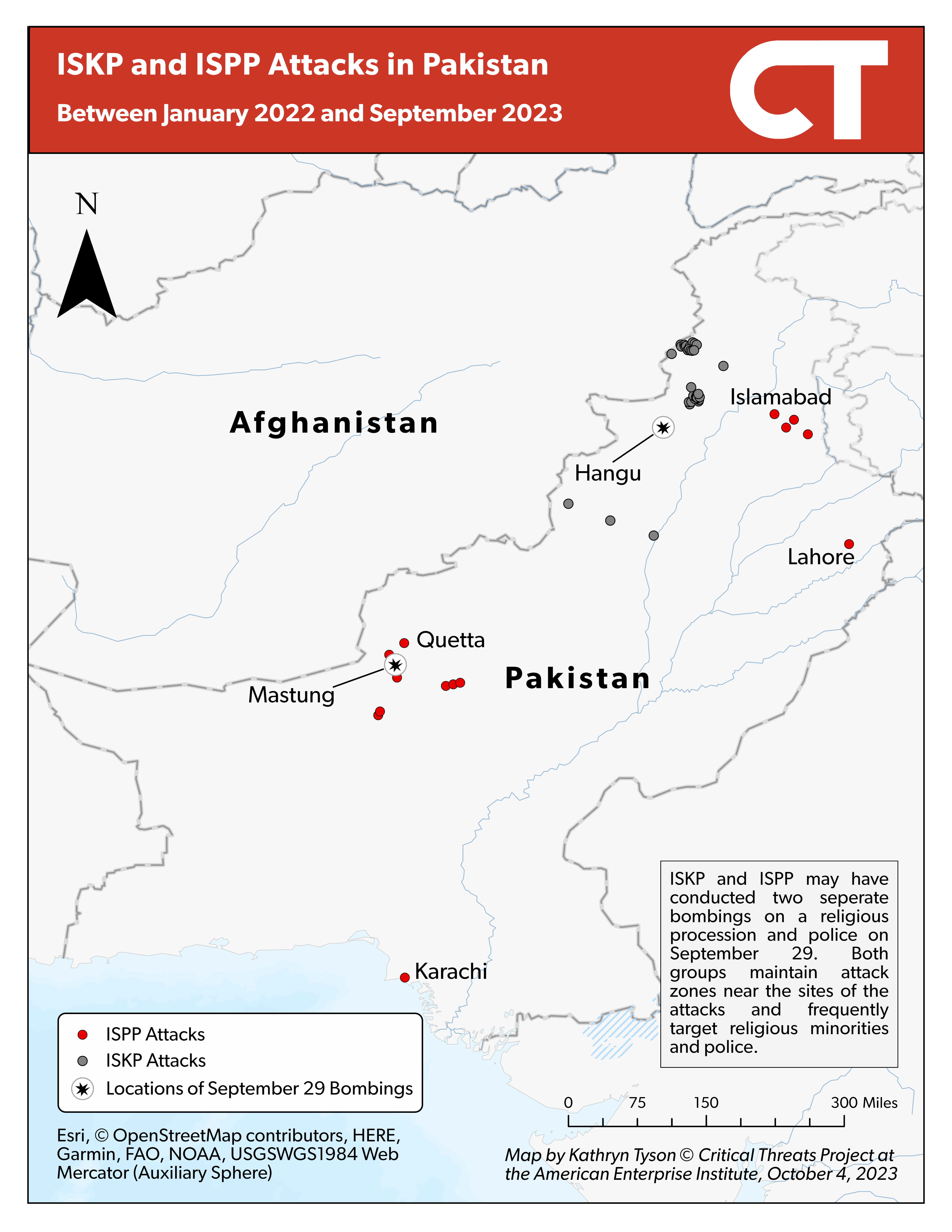
Source: Kathryn Tyson.
Pakistan and the Afghan Taliban are blaming each other for the bombings to reduce domestic pressure to defeat the groups responsible for the bombings. A pro-Taliban outlet said on October 1 that ISKP was responsible for the suicide bombings and that Pakistan is supporting ISKP.[85] Pakistan’s interior minister said on October 3 that Afghan nationals have carried out more than half the total number of suicide bombings in Pakistan in 2023, alluding to the bombings on September 29.[86]
The bombings are pressuring Pakistan to target groups such as the ISKP, ISPP, and TTP. Regional and international actors condemned the attacks and called on Pakistan to combat terrorist groups.[87] Religious bodies held demonstrations after the suicide bombings and demanded that Pakistan take action against terrorists.[88] CTP has previously assessed that Pakistan and the Taliban are ill-equipped and lack the will to deal with the escalating Salafi-jihadi threat.[89] Both countries seek to relieve this political pressure by blaming the attacks on one another.
Pakistan is responding to worsening insecurity by planning to deport one million Afghans, which will exacerbate political tensions between the Taliban and Pakistan and could increase support for the TTP. The Pakistani government announced on October 3 that it will begin deporting Afghans without residency documents and restrict Afghans’ ability to enter Pakistan on November 1.[90] The deportation of Afghans generally and Pashtuns specifically will put political pressure on the Taliban because of the Taliban’s predominantly Pashtun support base. The TTP continues to maintain support within the Afghan Taliban and in Pashtun communities along the border, which will be negatively affected by Pakistan’s deportations and border restrictions.[91]
Prior Pakistani abuses toward Afghans in Pakistan have led Taliban members to express support for the TTP and war with Pakistan. The Taliban called on Pakistan to halt its arrest and deportation of Afghans on October 3 and warned this would worsen bilateral relations.[92] The worsening relationship between the Taliban and Pakistan prevents the counterterrorism cooperation necessary to go after Salafi-jihadi terror groups, such as ISKP, which operate in both Afghanistan and Pakistan.
- Pakistan announced deportations and a change in document requirements that will severely limit Afghans’ ability to legally cross between Afghanistan and Pakistan. Pakistan said that after October 31, it would no longer accept a document normally used by Afghans to cross the border and that instead it would only accept passports.[93] The Taliban is unable issue enough passports for Afghans and frequently charges exorbitant prices, meaning most Afghans will be unable to secure proper documents to legally cross into Pakistan.[94] Pakistan arrested 10 times more Afghans in Karachi in September than it did in August, suggesting that the government intends to follow through with its threat to begin mass deportations of Afghans.[95]
- Pakistan’s deportations and border restrictions will anger local Pashtun tribes that live on both sides of the Afghanistan-Pakistan border, because Pakistan’s restrictions will harm their ability to move back and forth to maintain social ties and engage in trade.[96] Pakistan’s efforts to obstruct locals’ ability to move across the border negatively affects local businesses and divides communities. A 2021 border closure led locals to put political pressure on the Afghan government to lobby Pakistan to restore freedom of movement.[97] The TTP has also tried to exploit the situation by releasing propaganda claiming that the TTP defends Pashtun communities’ rights from the Pakistani state.[98]
- Taliban members responded to Pakistan’s abuse of Afghan migrants in September 2023 by expressing support for the TTP and threatening to fight Pakistan.[99] The Taliban’s minister of defense used a prior crisis in Taliban-Pakistan relations to echo anti-Pakistan rhetoric and grow his own domestic popularity in 2022.[100]
The Taliban will struggle to handle an influx of Afghan refugees and will likely try to weaponize the resulting humanitarian crisis to receive international support, which it will use to support its government. The Taliban government does not have the logistical capacity to provide food, water, and shelter necessary for the sudden arrival of hundreds of thousands of refugees. The arrival of hundreds of thousands of additional refugees would further strain the Taliban government’s ability to prevent mass hunger.[101] The Taliban has used natural disasters to receive international humanitarian assistance but frequently diverts such aid to support its government.[102]
- The Afghan state has previously struggled to deal with similar mass deportations of Afghan refugees from its neighbors. Iran deported more than 360,000 Afghan refugees in 2007, which created a humanitarian crisis that the Afghan government was unable to handle without international assistance.[103]
- Afghanistan’s economy has shrunk 20–30 percent since the Taliban takeover in 2021.[104] Ninety percent of Afghans face poverty and food insecurity.[105]
- The Taliban previously used a June 2022 earthquake in Paktika Province to receive international assistance, including $55 million from the US.[106] The US special inspector general for Afghanistan reconstruction reported in April 2023 that the Taliban were diverting aid to groups it favored but that he did not know how much US humanitarian assistance was going to the Taliban instead of needy Afghans.[107]
Figure 7. The Salafi-Jihadi Movement in Central and South Asia
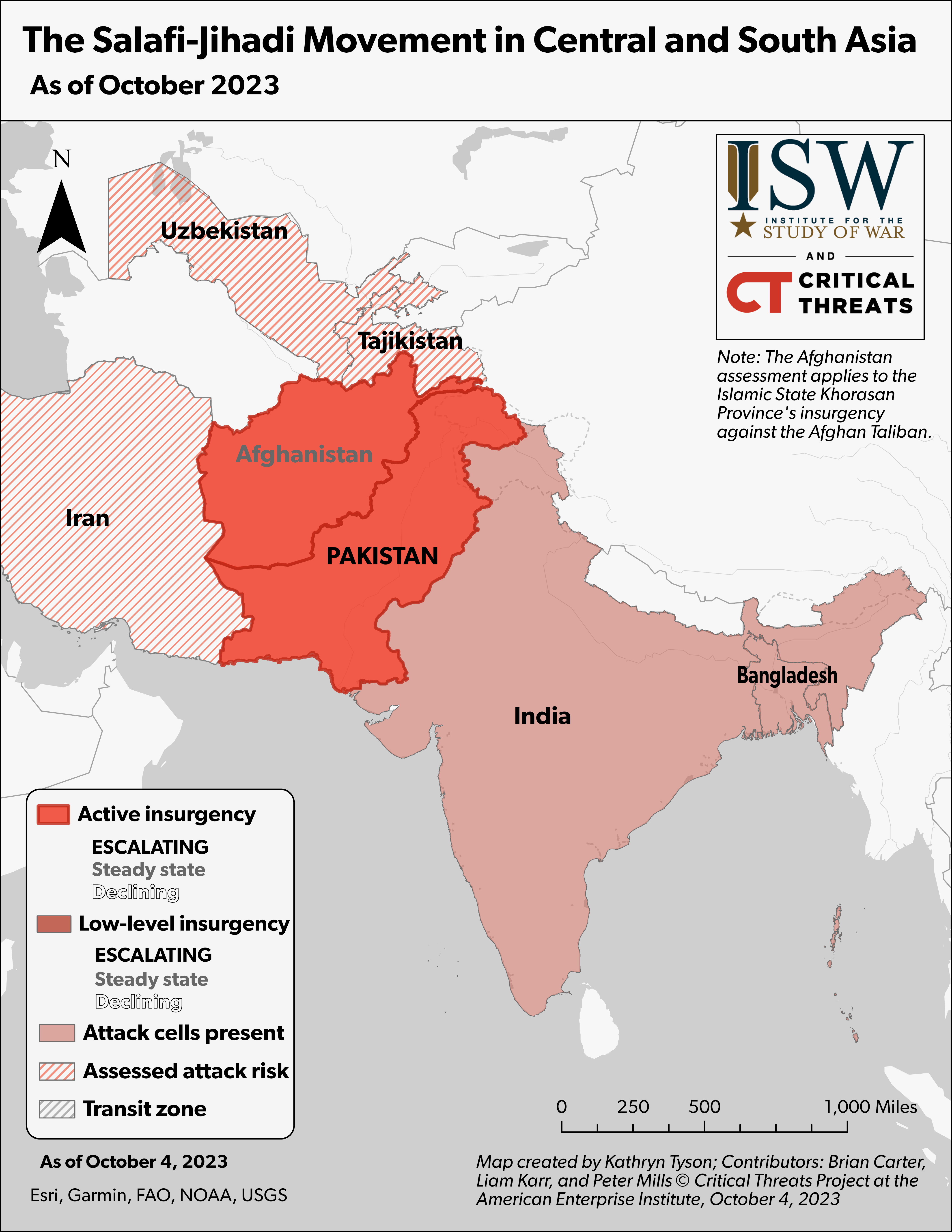
Source: Kathryn Tyson.
[1] Author’s database of significant activity (SIGACT). Sources available on request.
[2] https://akmckeever.substack.com/p/felix-legrand-on-deir-ez-zour-tribal?r=3swfv&utm_campaign=post&utm_medium=web#details
[3] https://akmckeever.substack.com/p/felix-legrand-on-deir-ez-zour-tribal?r=3swfv&utm_campaign=post&utm_medium=web#details
[4] https://akmckeever.substack.com/p/felix-legrand-on-deir-ez-zour-tribal?r=3swfv&utm_campaign=post&utm_medium=web#details
[5] https://akmckeever.substack.com/p/felix-legrand-on-deir-ez-zour-tribal?r=3swfv&utm_campaign=post&utm_medium=web#details
[6] Author’s database of SIGACT. Sources available on request.
[7] Author’s database of SIGACT. Sources available on request.
[8] Author’s database of SIGACT. Sources available on request; https://www.cnas.org/publications/reports/deir-azzour-tribal-mapping-project
[9] https://akmckeever.substack.com/p/felix-legrand-on-deir-ez-zour-tribal?r=3swfv&utm_campaign=post&utm_medium=web#details
[10] https://www.cnas.org/publications/reports/deir-azzour-tribal-mapping-project
[11] https://www.washingtoninstitute.org/policy-analysis/daeshs-forgotten-massacre-deir-al-zour
[12] https://syrianjihadism.files.wordpress.com/2023/10/clipboard-september-5-2023-10_04-am.png
[13] https://akmckeever.substack.com/p/felix-legrand-on-deir-ez-zour-tribal?r=3swfv&utm_campaign=post&utm_medium=web#details
[14] https://x.com/DeirEzzore/status/1701878014294790605?s=20
[15] https://www.inherentresolve.mil/WHO-WE-ARE
[16] https://www.alaraby dot co.uk/politics/%D9%82%D8%B3%D8%AF-%D8%AA%D8%AF%D9%81%D8%B9-%D8%A8%D8%AA%D8%B9%D8%B2%D9%8A%D8%B2%D8%A7%D8%AA-%D8%B9%D8%B3%D9%83%D8%B1%D9%8A%D8%A9-%D8%A5%D9%84%D9%89-%D8%AF%D9%8A%D8%B1-%D8%A7%D9%84%D8%B2%D9%88%D8%B1-%D9%88%D8%B3%D8%B7-%D8%A7%D8%B4%D8%AA%D8%A8%D8%A7%D9%83%D8%A7%D8%AA-%D9%85%D8%B9-%D8%A7%D9%84%D8%B9%D8%B4%D8%A7%D8%A6%D8%B1; https://x.com/DeirEzzore/status/1707316517577134327?s=20
[17] https://x.com/DeirEzzore/status/1701878014294790605?s=20
[18] https://www.inherentresolve.mil/WHO-WE-ARE
[19] https://www.criticalthreats.org/analysis/salafi-jihadi-movement-update-september-20-anti-syrian-democratic-forces-insurgency-continues-in-deir-ez-zor-kremlin-works-to-replace-wagner-in-the-sahel-is-in-pakistan-targets-politician-before-e#IraqSyria20230921
[20] https://akmckeever.substack.com/p/felix-legrand-on-deir-ez-zour-tribal?r=3swfv&utm_campaign=post&utm_medium=web#details
[21] https://www.criticalthreats.org/analysis/the-syrian-democratic-forces-arab-coalition-is-crumbling-creating-opportunities-for-isis-iran-and-turkey#_edn8a77c74a63b88806154e21a87c1167bdf74acdac9a36134b4f8e5aaefde100d9ref27
[22] https://twitter.com/thesyrianlions/status/1703054764055933059; https://twitter.com/thesyrianlions/status/1699121567790227790
[23] https://akmckeever.substack.com/p/felix-legrand-on-deir-ez-zour-tribal?r=3swfv&utm_campaign=post&utm_medium=web#details; https://ctc.westpoint.edu/the-islamic-states-shadow-governance-in-eastern-syria-since-the-fall-of-baghuz
[24] https://x.com/OrientNews/status/1706281820952711606?s=20; https://twitter.com/OrientNews/status/1706337820627914986
[25] https://www.carep-paris.org/wp-content/uploads/2023/05/Felix_Legrand_tibalisme_politique_DeirEzzor.pdf; https://www.cnas.org/publications/reports/deir-azzour-tribal-mapping-project
[26] https://www.tandfonline.com/doi/pdf/10.1080/09592318.2020.1713529?needAccess=true
[27] https://www.tandfonline.com/doi/pdf/10.1080/09592318.2020.1713529?needAccess=true
[28] Author’s database of SIGACT. Sources available on request.
[29] https://apnews.com/article/burkina-faso-soldiers-killed-attacks-b788c87aa365352426d5f3875ac7b356
[30] https://www.africaintelligence.com/west-africa/2023/07/14/animosity-grows-between-goita-and-defence-minister-camara,110003663-art; https://x.com/SalahMo73628462/status/1708124123887489336?s=20; https://x.com/tom_souris48765/status/1708957355805696202?s=20
[31] https://x.com/SalahMo73628462/status/1708538487299854476?s=20
[32] https://www.reuters.com/world/africa/burkina-faso-junta-says-it-thwarted-coup-attempt-tuesday-2023-09-27
[33] https://www.jeuneafrique.com/1484931/politique/au-burkina-faso-la-grogne-monte-dans-les-casernes
[34] https://x.com/ConstantinGouvy/status/1575926574314029063?s=20
[35] https://www.jeuneafrique.com/1467056/politique/au-niger-tentative-de-coup-detat-contre-mohamed-bazoum
[36] https://www.aljazeera.com/news/2021/11/17/burkina-faso-death-toll-security-post-attack-jumps-to-53; https://issafrica.org/iss-today/what-caused-the-coup-in-burkina-faso; https://www.bbc.com/news/world-africa-60112043
[37] https://www.voanews.com/a/civilians-killed-when-vehicle-hits-explosive-device-in-northern-burkina-faso-/6732742.html; https://www.reuters.com/world/africa/several-feared-dead-trucks-destroyed-burkina-faso-convoy-attack-2022-09-27; https://www.nytimes.com/2022/09/30/world/africa/burkina-faso-coup.html
[38] https://www.hudson.org/security-alliances/niger-coup-west-african-disaster-making-wagner-james-barnett; https://www.icct.nl/publication/unravelling-niger-coup-and-its-implications-violent-extremism-sahel
[39] https://www.criticalthreats.org/analysis/russian-offensive-campaign-assessment-october-2-2023; https://www.criticalthreats.org/analysis/salafi-jihadi-movement-update-september-20-anti-syrian-democratic-forces-insurgency-continues-in-deir-ez-zor-kremlin-works-to-replace-wagner-in-the-sahel-is-in-pakistan-targets-politician-before-e#Sahel20230921; https://www.lemonde.fr/en/le-monde-africa/article/2022/08/21/french-withdrawal-from-mali-the-closing-of-a-30-year-cycle-of-french-external-operations-in-africa_5994330_124.html; https://www.reuters.com/world/africa/burkina-faso-marks-official-end-french-military-operations-its-soil-2023-02-19; https://www.reuters.com/world/france-pull-troops-out-niger-following-coup-says-macron-2023-09-24; https://www.un.org/africarenewal/magazine/july-2023/un-mali-we-respect-government%E2%80%99s-decision-mission-withdrawal
[40] https://www.lemonde.fr/en/le-monde-africa/article/2022/08/21/french-withdrawal-from-mali-the-closing-of-a-30-year-cycle-of-french-external-operations-in-africa_5994330_124.html; https://www.reuters.com/world/africa/burkina-faso-marks-official-end-french-military-operations-its-soil-2023-02-19; https://www.reuters.com/world/france-pull-troops-out-niger-following-coup-says-macron-2023-09-24; https://www.un.org/africarenewal/magazine/july-2023/un-mali-we-respect-government%E2%80%99s-decision-mission-withdrawal
[41] https://www.brookings.edu/events/the-legacy-and-future-of-the-wagner-group
[42] https://africacenter.org/spotlight/inflection-point-for-africa-russia-relations-after-prigozhins-death; https://www.hrw.org/news/2023/07/24/mali-new-atrocities-malian-army-apparent-wagner-fighters; https://ctc.westpoint.edu/how-the-wagner-group-is-aggravating-the-jihadi-threat-in-the-sahel
[43] https://www.npr.org/2023/08/27/1196219007/russia-confirmed-yevgeny-prigozhin-died-in-plane-crash
[44] https://t.me/africaintel/5095; https://t.me/rybar/51841; https://t.me/grey_zone/20558; https://t.me/knyaz_cherkasky/1845; https://t.me/rybar/51839; https://t.me/grey_zone/2055; https://t.me/knyaz_cherkasky/184; https://t.me/rybar/51866
[45] https://www.lemonde.fr/en/le-monde-africa/article/2022/08/21/french-withdrawal-from-mali-the-closing-of-a-30-year-cycle-of-french-external-operations-in-africa_5994330_124.html; https://www.reuters.com/world/africa/burkina-faso-marks-official-end-french-military-operations-its-soil-2023-02-19; https://www.reuters.com/world/france-pull-troops-out-niger-following-coup-says-macron-2023-09-24
[46] https://www.reuters.com/world/africa/un-mali-mission-resume-flights-suspended-because-sanctions-2022-01-20; https://media.un.org/en/asset/k10/k10efpi0ms; https://www.un.org/africarenewal/magazine/july-2023/un-mali-we-respect-government%E2%80%99s-decision-mission-withdrawal
[47] https://www.criticalthreats.org/analysis/salafi-jihadi-movement-update-september-13-sdf-lose-legitimacy-in-deir-ez-zor-al-qaeda-and-the-islamic-state-expand-in-west-africa-ttp-launches-offensive-in-pakistan#Mali20230913; https://africacenter.org/spotlight/burkina-faso-crisis-continues-to-spiral
[48] Author’s database of SIGACT. Sources available on request; https://africacenter.org/spotlight/mali-catastrophe-accelerating-under-junta-rule; https://africacenter.org/spotlight/burkina-faso-crisis-continues-to-spiral
[49] https://www.lapresse.ca/international/afrique/2023-09-08/nord-du-mali/attaque-suicide-contre-un-camp-militaire-au-lendemain-d-une-double-attaque-meurtriere.php; https://www.reuters.com/world/africa/al-qaeda-affiliate-claims-attack-malis-main-military-base-2022-07-23
[50] https://www.crisisgroup.org/africa/horn-africa/somalia/b187-sustaining-gains-somalias-offensive-against-al-shabaab
[51] https://www.criticalthreats.org/analysis/salafi-jihadi-movement-weekly-update-january-25-2023; https://www.criticalthreats.org/analysis/salafi-jihadi-movement-weekly-update-june-14-2023#SOM20230614; https://www.reuters.com/world/africa/somalia-plans-eliminate-al-shabaab-months-analysts-sceptical-2023-08-18; https://www.voanews.com/a/7245333.html
[52] https://twitter.com/HarunMaruf/status/1699817775374516508; https://x.com/HarunMaruf/status/1703632032440479980?s=20
[53] Author’s database of SIGACT. Sources available on request.
[54] https://www.criticalthreats.org/analysis/salafi-jihadi-movement-weekly-update-february-8-2023; https://x.com/FAOSomalia/status/1708838913656131765?s=20
[55] https://twitter.com/HarunMaruf/status/1699817775374516508; https://x.com/HarunMaruf/status/1703632032440479980?s=20
[56] https://shabellemedia dot com/faah-faahino-ka-soo-baxay-duqeymo-ka-socda-gobolka-shabeelaha-dhexe; https://x.com/HarunMaruf/status/1709243460790759699?s=20
[57] https://x.com/HarunMaruf/status/1708691876700626987?s=20
[58] https://www.voanews.com/a/7245333.html
[59] https://www.voanews.com/a/7245333.html; https://www.caasimada dot net/deg-deg-ciidamada-df-oo-degmo-cusub-kala-wareegay-al-shabaab
[60] Author’s database of SIGACT. Sources available on request.
[61] https://www.voanews.com/a/somalia-shifts-military-tactics-in-fight-against-al-shabab/7256956.html
[62] SITE Intelligence Group, “Shabaab Video Documents Aftermath of Major Operation in Budbud Inflicting 50+ Casualties,” April 24, 2023, available by subscription at www.siteintelgroup.com; https://apnews.com/article/somalia-alshabab-militants-attack-cccdfe445f1e3790df3db12bc504acc5; author’s database of SIGACT. Sources available on request.
[63] Author’s database of SIGACT. Sources available on request.
[64] https://shabellemedia dot com/somalia-president-calls-for-a-united-front-to-defeat-al-shabaab; https://www.caasimada dot net/daawo-wasiiro-ka-tirsan-df-iyo-xildhibaano-oo-gaaray-furinta-kuna-booriyay-ciidanka-in; https://www.radiodalsan dot com/major-clan-leaders-unite-to-battle-al-shabaab-militants-in-galmudug-and-hirshabelle
[65] https://www.caasimada dot net/al-shabab-launches-surprise-attack-on-somali-military-base
[66] https://www.criticalthreats.org/analysis/salafi-jihadi-movement-weekly-update-april-12-2023; https://www.caasimada dot net/sawirro-ciidanka-duulaanka-ku-ah-ceelbuur-oo-deegaan-muhiim-ah-qabsaday-shalay; https://en.halbeeg dot com/2022/10/25/sna-forces-recapture-small-town-in-central-somalia; https://goobjoog dot com/english/sna-troops-drive-out-khawarij-militants-from-whabo-town-ending-a-15-year-siege; https://radiorisaala dot com/howlgallo-ka-socda-degaano-ka-kala-tirsan-gobolada-hiiraan-mudug; https://www.garoweonline dot com/en/news/somalia/somalia-detains-elders-over-links-to-al-shabaab; https://www.crisisgroup.org/africa/horn-africa/somalia/b187-sustaining-gains-somalias-offensive-against-al-shabaab
[67] SITE Intelligence Group, “Shabaab Video Documents Aftermath of Major Operation in Budbud Inflicting 50+ Casualties,” April 24, 2023, available by subscription at www.siteintelgroup.com; https://apnews.com/article/somalia-alshabab-militants-attack-cccdfe445f1e3790df3db12bc504acc5; author’s database of SIGACT. Sources available on request.
[68] Author’s database of SIGACT. Sources available on request.
[69] https://www.voanews.com/a/7245333.html
[70] https://twitter.com/sntvnews1/status/1698322836132090271?s=20; https://sonna dot so/en/president-hassan-sheikh-meets-mps-politicians-and-government-officials; author’s database of SIGACT. Sources available on request.
[71] https://www.caasimada dot net/habar-gidir-murusade-iyo-xawaadle-oo-ku-heshiiyay-in
[72] https://acleddata.com/2023/04/21/somalia-situation-update-april-2023-counter-insurgency-operation-gains-regional-support-in-phase-two-as-al-shabaab-attacks-and-political-differences-persist
[73] https://x.com/HShPrez2Ware/status/1707766721849786558?s=20; https://www.criticalthreats.org/analysis/salafi-jihadi-movement-weekly-update-april-27-2023#Somalia20230427
[74] https://www dot dawn dot com/news/1778910
[75] https://www.reuters.com/world/asia-pacific/death-toll-pakistan-blast-rises-59-minister-blames-india-2023-09-30; https://twitter.com/SaleemMehsud/status/1707704667122319760; https://twitter.com/ShabbirTuri/status/1707689409506947154
[76] https://ctc.westpoint.edu/fixing-cracks-pakistani-talibans-foundation-ttps-leadership-returns-mehsud-tribe; https://www.criticalthreats.org/analysis/salafi-jihadi-movement-weekly-update-february-1-2023
[77] https://twitter.com/ShabbirTuri/status/1707705256988320057
[78] https://ctc.westpoint.edu/fixing-cracks-pakistani-talibans-foundation-ttps-leadership-returns-mehsud-tribe
[79] https://www.cnn.com/2023/01/31/asia/pakistan-peshawar-mosque-blast-tuesday-intl-hnk/index.html
[80] https://www.csis.org/analysis/islamic-state-threat-pakistan-trends-and-scenarios
[81] https://www.criticalthreats.org/briefs/al-qaeda-global-tracker/islamic-state-increases-attacks-as-pakistani-taliban-negotiates; https://www.hrw.org/news/2022/09/06/afghanistan-isis-group-targets-religious-minorities
[82] https://www.criticalthreats.org/briefs/al-qaeda-global-tracker/islamic-state-increases-attacks-as-pakistani-taliban-negotiates
[83] https://twitter.com/Natsecjeff/status/1626507197449371649?s=20&t=CJWJZ7hzHqhqBjb4wy1UDA; https://twitter.com/khorasandiary/status/1628410766532530178?s=20; https://twitter.com/cozyduke_apt29/status/1690017989175988224?s=20; https://twitter.com/khorasandiary/status/1695168580977823755; https://twitter.com/KhyberScoop/status/1699828766715891995; https://twitter.com/khorasandiary/status/1702253502876258552
[84] https://www.csis.org/analysis/islamic-state-threat-pakistan-trends-and-scenarios; https://twitter.com/DK_Hunzai/status/1599680699409518592; https://henryjacksonsociety.org/wp-content/uploads/2017/10/HJS-ISIS-Khorasan-Report.pdf; https://twitter.com/Valle_Riccardo_/status/1440377092206514178; https://twitter.com/TracTerrorism/status/1548976264303845377; https://twitter.com/AfghanAnalyst2/status/1664493186570493953; https://twitter.com/AfghanAnalyst2/status/1665124095774605314; https://twitter.com/ShabbirTuri/status/1672260942367965184; https://twitter.com/AfghanAnalyst2/status/1672642805427064834
[85] https://twitter.com/AfPak_monitor/status/1708560095175467409; https://twitter.com/Natsecjeff/status/1708184513573220738
[86] https://twitter.com/khorasandiary/status/1709169655628136591; https://twitter.com/basitresearcher/status/1709185099529687316
[87] https://dunyanews dot tv/en/Pakistan/758897-US-UK-condemn-Mastung-terrorist-attack; https://english dot news dot cn/20230930/24e5660b1b104ae49cc166ecfe6ef113/c.html
[88] https://abcnews.go.com/International/wireStory/death-toll-pakistan-bombing-rises-54-suspicion-falls-103622054
[89] https://www.criticalthreats.org/analysis/salafi-jihadi-movement-weekly-update-august-31-2023#Pakistan20230831; https://www.criticalthreats.org/analysis/salafi-jihadi-movement-weekly-update-august-24-2023#Afpak20230824; https://www.criticalthreats.org/analysis/salafi-jihadi-movement-update-september-13-sdf-lose-legitimacy-in-deir-ez-zor-al-qaeda-and-the-islamic-state-expand-in-west-africa-ttp-launches-offensive-in-pakistan#AFPAK20230913
[90] https://www dot dawn dot com/news/1779106/govt-sets-deadline-of-nov-1-for-illegal-immigrants-to-leave-pakistan; https://twitter.com/AnasMallick/status/1709167808213348760; https://www.voanews.com/a/pakistan-tightens-entry-rules-for-afghan-travelers/7294362.html
[91] https://www.usip.org/publications/2023/02/pakistan-poised-take-ttp; https://www.usip.org/publications/2022/05/pakistans-twin-taliban-problem; https://ctc.westpoint.edu/the-tehrik-i-taliban-pakistan-after-the-talibans-afghanistan-takeover
[92] https://twitter.com/AfghanembassyI1/status/1709169597549813988; https://twitter.com/afghananalyst2/status/1709221556939809270?s=46
[93] https://www dot dawn dot com/news/1779106/govt-sets-deadline-of-nov-1-for-illegal-immigrants-to-leave-pakistan
[94] https://www.voanews.com/a/taliban-make-millions-from-passports-issued-to-fleeing-afghans/6715133.html; https://kabulnow dot com/2023/01/passports-how-taliban-officials-have-turned-the-worlds-weakest-into-the-most-expensive
[95] https://www dot dawn dot com/news/1778946/govt-decides-to-evict-over-1m-foreigners-illegally-residing-in-pakistan-state-media
[96] https://www.cfr.org/backgrounder/troubled-afghan-pakistani-border; https://www.stimson.org/2021/fencing-the-afghanistan-pakistan-border
[97] https://www.rferl.org/a/pakistan-afghan-border-pashtun-lose-business-rights-tribal-ties/31258865.html
[98] https://ctc.westpoint.edu/the-tehrik-i-taliban-pakistan-after-the-talibans-afghanistan-takeover
[99] https://twitter.com/aamajnews_EN/status/1702296171325059167; https://twitter.com/AfghanAnalyst2/status/1704487231702897093?s=20
[100] https://twitter.com/abdsayedd/status/1595126859142148098; https://twitter.com/azrawall/status/1595027956677869569
[101] https://www.usip.org/publications/2022/08/one-year-later-taliban-unable-reverse-afghanistans-economic-decline
[102] https://www.voanews.com/a/us-watchdog-group-says-taliban-diverting-controlling-afghanistan-humanitarian-aid/7189336.html; https://www.npr.org/sections/goatsandsoda/2023/06/23/1180464339/charities-say-taliban-intimidation-diverts-aid-to-taliban-members-and-causes; https://thediplomat.com/2023/08/the-taliban-are-diverting-aid-but-how-much
[103] https://www.hrw.org/news/2007/06/19/iran-halt-mass-deportation-afghans; https://reliefweb.int/report/afghanistan/afghanistan-mass-deportation-iran-may-cause-crisis-official-warns
[104] https://www.undp.org/sites/g/files/zskgke326/files/2023-05/SEO%202023_full%20report.pdf; https://www.worldbank.org/en/country/afghanistan/overview
[105] https://www.ipcinfo.org/ipcinfo-website/resources/resources-details/en/c/1155598; https://www.undp.org/sites/g/files/zskgke326/files/2023-05/SEO%202023_full%20report.pdf
[106] https://www.usaid.gov/news-information/press-releases/jun-28-2022-united-states-provides-nearly-55-million-additional-funding-afghanistan; https://www.unhcr.org/news/briefing-notes/unhcr-rushes-relief-supplies-humanitarian-staff-afghanistans-earthquake-hit
[107] https://www.aljazeera.com/news/2023/4/19/us-watchdog-cannot-assure-afghanistan-aid-not-going-to-taliban
